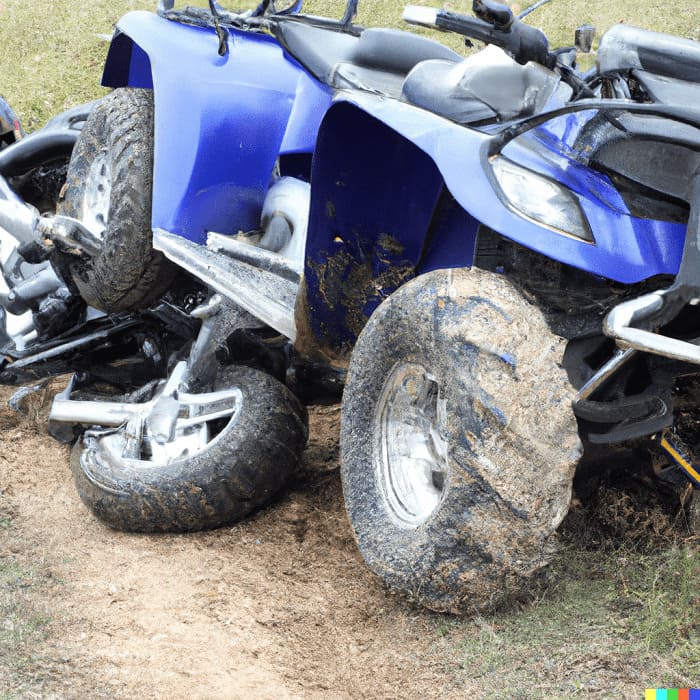Can ATVs be used on Ice? Safety Tips for driving an ATV on Ice

ATVs are best for driving in rugged and severe conditions, but can they be used on Ice in the winter season? It can be tempting to take your ATV out on the ice when the weather turns cold, but be aware of the dangers. ATV riders are generally not as skilled as drivers of other types of vehicles when it comes to winter driving.
Ice can be very slippery, and snow can create large drifts that can be difficult to maneuver your ATV around. But if your ATV is compact and lightweight, then it can be able to drive on the ice depending upon the thickness of ice layers. This means how much thickness of ice layers can bear the weight of an ATV.
Since, we tested our ATVs while driving on ice, we came to know that some ATVs work very better on ice as compared to few other vehicles. But if the thickness of ice layers is not enough to support the weight of the vehicle, it can be very dangerous while driving an ATV. We will explain in detail below how to drive an ATV on ice correctly and safely.
Are ATVs a good option for driving on Ice?
If you are fond of driving ATVs on ice for any purpose, the answer is YES. ATVs are good for driving on ice. Before driving this vehicle on ice, you must ensure that there is enough clearance between the wheels of your ATV and the ground. This will definitely overcome the difficulty of being stuck while riding over any patch of ice.
Most ATVs are equipped with powerful engines which can not only be used for moving a vehicle but also used for various other tasks including transportation, farming and construction work. Due to their heavy engine size, the ATVs are the best option for snow plowing and ice fishing in the winter season.
Weight of an ATV is considered as one of the important factors while driving on ice or snow. Lightweight ATVs are safe to use on ice because of their less weight; so these do not insert more pressure on ice.
If we talk about the general performance of an ATV on ice, then ATVs are a good option for ice. These vehicles are specially designed with an engineering mind and keeping all factors accordingly. These factors help an ATV to grip the ice surface instead of sliding on it.
Due to the lower centre of gravity of ATVs, the chances of rolling over are minimal. This lower centre of gravity assists these vehicles to maintain balance and stability on ice and snow.
Performance and Safety Tips to keep in Mind
When riding an ATV on ice, it is important to take the time to understand the risks and to follow basic safety precautions. It is also important to be aware of the special precautions that need to be taken when riding an ATV in snow.
Riding an ATV on ice can be a fun and exhilarating experience, but it is also risky. The following tips can help make your experience safe and enjoyable.
(1) Prepared Cold Weather Gears
First and foremost, make sure you have the proper gear. ATV riding is a great way to get some exercise, but it’s important to remember that ice and snow can be dangerous. Make sure you wear a helmet, long pants, and closed-toe shoes. These supplies will help keep you safe in the event of a crash.
(2) Inspection of Vehicle before Riding
While you go for driving an ATV on ice, you must inspect the vehicle before riding. Inspect tires specially and make sure they are inflated and there should be no crack and less air pressure.
Also, inspect for other things of the vehicle like fluid levels and spark plugs to make sure that the machine is in good working condition.
(3) Use Tire Snow chains on ATV tires
When driving your ATV on ice and snow, it is important to use proper tire chains. Tire chains can prevent your ATV from spinning out and sliding uncontrollably. When driving on ice or snow, it is important to be cautious and use chains on the tires of your ATV.
If you are not using chains, your ATV may slip and skid. Chain use also helps protect your ATV and yourself from injury in the event of a fall. Also, people living in snowy areas must use Tire snow chains on vehicles specially in the snowfall winter season.
(4) Use Special Snow Tires for Ice
When driving on ice, it is important to have tires that are made for the icy conditions. Snow-grade tires are designed to have a better grip on slippery surfaces.
Make sure to get the right size tires for your car. Snow-grade tires are available in various sizes, so you’ll need to know the size of your car’s wheels in order to get the right ones. They are also made to be more durable so they can withstand the cold temperatures and the extra weight from the snow.
(5) Use brakes gently
When it comes to driving on icy roads, it’s important to take things slow and easy. Braking gently is key, as slamming on the brakes can cause the tires to slide and make it more difficult to stop. This can be dangerous, and losing control of your ATV on ice can be scary.
When you stop the vehicle, try to avoid putting all your weight on heels and also do not put much weight on any side of the ATV at a time.
(6) Do not Accelerate the vehicle too much
When you’re out on an ATV and driving on ice, be careful when accelerating on ice or snow. If you accelerate too aggressively, you could cause the ATV to lose traction and spin. This would lead to a loss of speed and control.
Increase the accelerator slowly and gently when you start driving the vehicle on an ice surface. This will help your vehicle to avoid slipping or the tires spinning excessively.
Thickness of Ice to Support ATV
There are a few factors that come into play when determining how thick the ice needs to be, such as the weight of the ATV, the size of the tires, and the temperature of the water. In general, though, the ice needs to be at least four inches thick in order to support an ATV.
This is because ATVs are heavy vehicles and can create a lot of pressure on the ice. If the ice is too thin, it could crack and break, which could lead to serious injuries. According to research, a four inch thick ice layer can support up to 200-250 pounds of weight before cracking starts.
Any ATV having weight above the certain limit can make a risky ride for the driver. For a heavyweight ATV, the thickness of ice must be seven to eight inches to bear that weight.
Driving an ATV on Ice is Safe or not?
It is safe to drive an ATV on ice but it can be risky depending upon the conditions. Drive the ATV on ice with good tactics and caution. Beware of driving too fast on thin ice surfaces.
While starting driving on ice, make sure to know the abilities and limitations of your vehicle. Always wear a helmet and other safety essentials when driving on ice. Keep your vehicle in good condition such as its tires etc.
Always start driving on ice with proper safety and driving training from an expert. If you are driving for the first time, it will be very difficult for you. Proper guidance and training will help you in controlling the vehicle on slippery and other rough surfaces with ease.
How to know Ice Thickness
For safe driving on ice, you must know the thickness of ice layers before starting driving. But how to know the thickness of ice? So, there are many ways to check the thickness.
One of the easiest methods is the color and shade method. In this method, the observer deeply analyzes the color and shade of ice. If the color of ice is light blue, it is strongest and thickest. This type of ice has a thickness of about six to eight inches.
On the other hand, if the color of ice is darker and greyish, it is considered to be thin and weakest ice. This type of ice is dangerous even for walking on foot.
Best Size of ATV for driving on Ice
The best size of an ATV for driving on ice depends upon many factors including the weight of vehicle and driver, age and experience of driver etc. In my experience, a 400cc ATV is the best one for driving on ice because of its lightweight body , power and stability.
But this vehicle has a weight of about 450-500 pounds. To bear this much weight, the thickness of ice should be 4-6 inches. The weight is the issue with this type of vehicle. To remain in a safe zone, we recommend a 200cc ATV which has less weight.

About Julia P. Charlotte
Julia P. Charlotte is a social media star with a Bachelor’s in Media Sciences. I am a blogger and affiliate marketer, and loves driving and exploring new vehicles specially ATVs and UTVs. I am an expert at creating content that engages and entertains my followers, and also has a huge following of loyal fans. If you’re looking for someone to follow who knows a thing or two about the social media world, Julia P. Charlotte is the perfect person for you.






